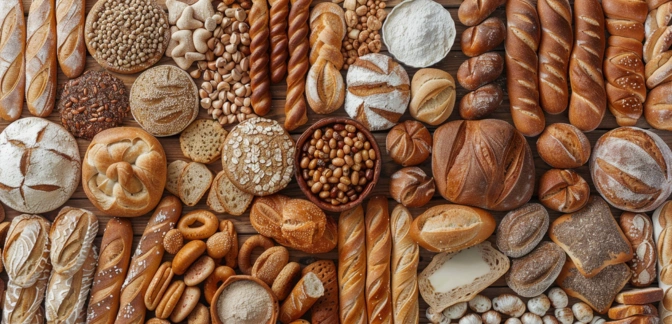Garlic Bread — Nutrients, Health Benefits, And Shopping Tips

Written by Listonic Team
Last update on September 4, 2024
Nutrition facts
Nutrition facts
Amount per 100 g
Calories
🔥 350 kcal
| Nutrition per: 100 g | Value | % Daily Value* |
|---|---|---|
| Carbs | 49 g | 17.82% |
| Fiber | 3 g | 10.71% |
| Sugars | 1 g | 2% |
| Glycemic Index | 73 | - |
| Protein | 9 g | 18% |
| Sodium | 400 mg | 17.39% |
| Total Fat | 14 g | 17.95% |
*The % of Daily Value (DV) tells you how much a nutrient in a serving of food contributes to a daily diet. 2,000 calories a day is used for general nutrition advice.
1 g
🍏 Low Sugar Content
Did you know?
Health benefits
- Contains antioxidants from garlic, which help protect the body from free radicals and reduce inflammation.
- Provides quick energy from carbohydrates, making it a convenient source of fuel.
- Enhances flavor and enjoyment of meals, making them more satisfying and palatable.
Health risks
- High fat content particularly in garlic bread made with butter or oil, which can raise cholesterol levels and increase the risk of heart disease when consumed frequently.
- High carbohydrate content as garlic bread is typically made with white bread, which can cause rapid spikes in blood sugar levels, particularly concerning for diabetics.
- High calorie content which can contribute to weight gain if consumed frequently or in large portions.
- Risk of digestive discomfort such as heartburn or stomach upset, particularly in individuals sensitive to garlic or fatty foods.
How to choose garlic bread
Garlic bread is best when it has a crispy crust and a soft, buttery center infused with garlic. The garlic should be evenly distributed, and the bread should not be overly oily. Check that the bread is golden brown and has a robust garlic aroma.
Do not choose garlic bread that is soggy or scantily topped with garlic. Quality garlic bread should offer a satisfying crunch and a rich, garlicky flavor that complements its buttery texture.

How to store garlic bread
Garlic bread should be stored at room temperature in an airtight container. Wrap it in aluminum foil or place it in a plastic bag to maintain its freshness. Properly stored, garlic bread can last up to two days.
Exposure to air can make garlic bread dry and hard. It's best to avoid refrigerating it, as this can alter its texture. Reheating in the oven can help restore its crispiness and flavor if needed.
✅ Extra Tip
How long does it last?
Garlic bread can last for 1-2 days at room temperature when stored in an airtight container. If refrigerated, it can last for 3-5 days. For longer storage, garlic bread can be frozen for up to 3 months.
What to do with leftovers?
Leftover garlic bread can be repurposed into a variety of tasty dishes. Reheat it in the oven or toaster for a quick snack, or chop it up and use as croutons for salads or soups. Garlic bread is also great when used as a base for mini pizzas, topped with sauce, cheese, and your favorite toppings.
Use garlic bread as a side for pasta dishes or soups, where its buttery, garlicky flavor complements the meal. If you have a lot of garlic bread, consider turning it into a bread pudding with eggs, cheese, and herbs, or using it as a stuffing for vegetables or meats. Garlic bread can also be blended into breadcrumbs and used as a coating for chicken or fish, or added to a casserole for a crispy topping. For a quick snack, toast garlic bread slices and serve with a dipping sauce like marinara or ranch.
👨⚕️️ Medical disclaimer
Discover products from other categories
Listonic Team
Fact-checked
Our editorial team checked this article to make sure it was accurate at the time of publishing it.
Get the top-rated shopping list app

garlic bread
1 piece







